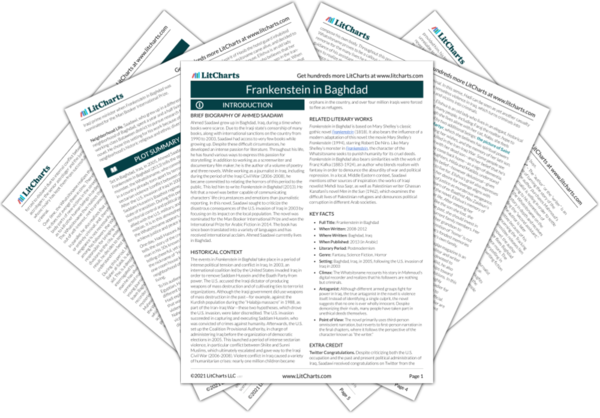Welcome to the LitCharts study guide on Ahmed Saadawi's Frankenstein in Baghdad. Created by the original team behind SparkNotes, LitCharts are the world's best literature guides.
Frankenstein in Baghdad: Introduction
Frankenstein in Baghdad: Plot Summary
Frankenstein in Baghdad: Detailed Summary & Analysis
Frankenstein in Baghdad: Themes
Frankenstein in Baghdad: Quotes
Frankenstein in Baghdad: Characters
Frankenstein in Baghdad: Terms
Frankenstein in Baghdad: Symbols
Frankenstein in Baghdad: Theme Wheel
Brief Biography of Ahmed Saadawi

Historical Context of Frankenstein in Baghdad
Other Books Related to Frankenstein in Baghdad
- Full Title: Frankenstein in Baghdad
- When Written: 2008-2012
- Where Written: Baghdad, Iraq
- When Published: 2013 (in Arabic)
- Literary Period: Postmodernism
- Genre: Fantasy, Science Fiction, Horror
- Setting: Baghdad, Iraq, in 2005, following the U.S. invasion of Iraq in 2003
- Climax: The Whatsitsname recounts his story in Mahmoud’s digital recorder and realizes that his followers are nothing but criminals.
- Antagonist: Although different armed groups fight for power in Iraq, the true antagonist in the novel is violence itself. Instead of identifying a single culprit, the novel suggests that no one is ever wholly innocent. Despite demonizing their rivals, many people have taken part in unethical deeds themselves.
- Point of View: The novel primarily uses third-person omniscient narration, but reverts to first-person narration in the final chapters, where it follows the perspective of the character known as “the writer.”
Extra Credit for Frankenstein in Baghdad
Twitter Congratulations. Despite criticizing both the U.S. occupation and the past and present political administration of Iraq, Saadawi received congratulations on Twitter from the Iraqi prime minister when Frankenstein in Baghdad was nominated for the Man Booker International Prize.
Neighborhood Life. Saadawi, who grew up in a different neighborhood of Baghdad, spent a year and a half living in the working-class Bataween district to pursue research for his novel. He chose this setting for his work because of the neighborhood’s historic religious and ethnic diversity.







